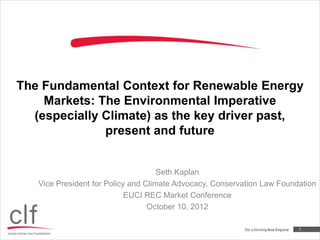
Seth Kaplan presentation at EUCI conference on Renewable Energy Markets in New England
- 1. The Fundamental Context for Renewable Energy Markets: The Environmental Imperative (especially Climate) as the key driver past, present and future Seth Kaplan Vice President for Policy and Climate Advocacy, Conservation Law Foundation EUCI REC Market Conference October 10, 2012 1
- 2. Environmental Imperatives: Past, Present and Future • Where did these markets come from? – The environmental interests led broad coalition: explicit decision to “move the cheese” and build a new market that would have positive impact on emissions • Current state of instability in part due to policy ambivalence – New Jersey and Maine are great case studies in the odd mix of ideological and political pressures that are playing out on the ground • The future is defined by a struggle between those preserving entrenched investments and the enviro-clean energy coalition – The climate imperative means that we can not play around with (just) niche clean energy plays – we need the boldness that nuclear and oil industries have shown in defending their policy and financial supports because we need zero emissions energy technologies to “go big” in a very significant way 2
- 3. Fundamental Context: A Warming World Various govt. and academic models and papers compiled, with citations at http://www.realclimate.org/index.php/archives/2012/05/ohc-modelobs-comparison- errata/
- 4. On a highway to hell: “business as usual” buys us radically different planet. Scary part: this is looking conservative 12 C change (current trajectory gets us there by 2300) likely means over half of earth’s surface totally uninhabitable by humans and similar animals. Sherwood & Huber, An adaptability limit to climate change due to heat stress (2010).
- 5. The Electricity Sector is the “hinge” for the whole economy – illustrative example from European Roadmap 2050 5
- 6. Achieving these reductions require massive solar & wind ramp up – 3 scenarios from EU Roadmap 2050 show general direction Note, new fossil assumed to have carbon capture post 2030, generally 6
- 7. The ultimate “Valley of Death” question One sad possibility: we might be HERE in history of renewable energy deployment in the U.S. • Will we make the journey needed to build a safer world? • Will we accept that there are snipers shooting at us as we make the journey? – Why was Solyndra a big deal? – Taking on the most profitable companies & industries in the history of money – Enviro community finally fighting back: 350/McKibben “Do the Math”, CLF – Cape Wind Now ! campaign. 7
- 8. Mass. Global Warming Solutions Act and regional climate consensus – policies that are needed to drive carbon price are alive, well and in effect here New Synapse Energy Economics analysis: Mild climate policy yields carbon prices $25 - $70/ton The challenge for the New England states, and Connecticut and Massachusetts in particular, is whether we will live up to the science motivated mandates on the books – getting beyond the artificially low prices set by RGGI. Tremendous need for honesty in what emissions reducing steps are being taken and what effects they will have. 8
- 9. The Bottom Line: Renewable Energy markets and environmental policy cannot be separated • As oil and coal retires there is a need for new Megawatts • Only candidates on the field are Demand, Renewables and Gas (even if you see role for nuclear down the line, it isn’t happening soon) • Fast ramp gas and flexible load (and hydro) can fit together with variable renewables to build a portfolio for the short to medium term • But environmental and especially, climate, imperative limits long term role of gas (and to some extent large hydro) • Are the right signals going to be sent? And in time? Being right at the wrong time can be a disaster, for you and (as it turns out) for the planet . . . 9
